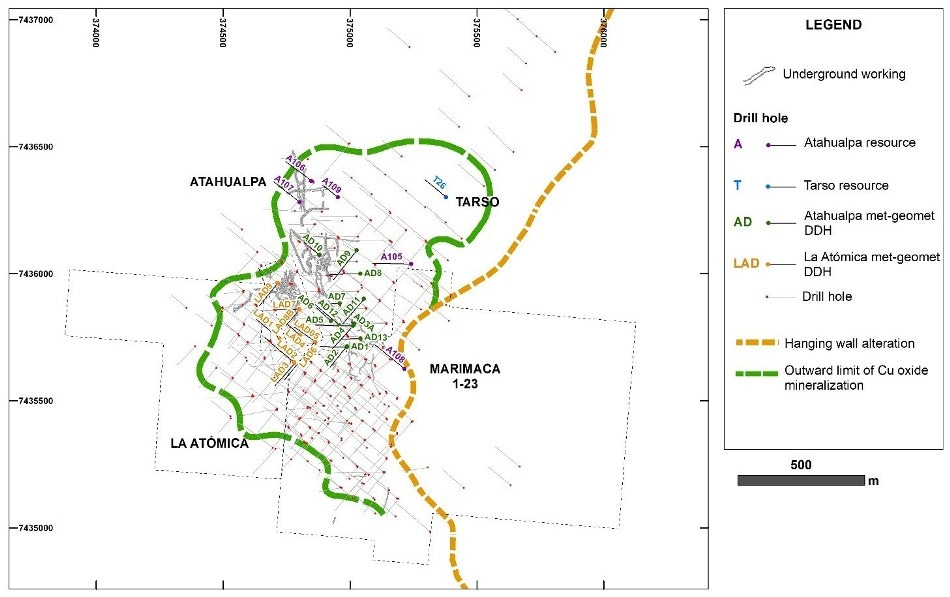Oct 4 2019
Coro Mining Corp. has provided a report on its Phase II drilling program at the Marimaca Project located in the Antofagasta Region of Chile. The program is aimed at expanding the identified resources.
 Drill hole locations. (Image credit: Coro Mining Corp.)
Drill hole locations. (Image credit: Coro Mining Corp.)
A restructured resource estimate is slated for release in October. With Coro’s recently consolidated 100% ownership of the whole project, a Preliminary Economic Assessment (“PEA”) based on this new resource will start directly thereafter.
So far, 91,210 m have been drilled across the various zones, including the Marimaca area in 385 holes (346 reverse circulation (“RC”) and 39 diamond drill holes (“DDH”). Phase II drilling fruitfully extended the mineralized area to the north.
Currently, this area measures about 700 m by 1400 m and has a thickness of 100 to 300 m. The deposit contains a minimum of five clearly marked higher-grade zones, three of which begin from the surface.
The Phase II exploration program has exceeded our expectations. Following up encouraging results as the program advanced, we effectively doubled the metres drilled. These additional drill holes and metres have improved our knowledge, notably the discovery of multiple new high-grade zones, which bodes well for our forthcoming resource estimate.
Sergio Rivera, VP of Exploration, Coro Mining
Upon receiving the resource estimate, Coro intends to directly start a PEA with the focus of finishing it during the first quarter of 2020.
Phase II Drilling Detail
The $10.6 million Marimaca Phase II drilling program started in Q4 2018 and was prepared to establish the extension of the orebody across the Atahualpa, Atómica, and Tarso zones close to the main Marimaca 1-23 zone.
La Atómica saw 16,150 m drilled in 70 RC holes and 2203 m drilled in nine DDH for 18,353 m. The program’s aim was to additionally define and delineate the mineralization and follow-up on the 3220 m of discovery RC drilling finished in 2017 and 2018.
Following drilling at La Atómica, the westward continuation of the mineralization from the original Marimaca 1-23 claim and also the noticeable north-south oriented feeder type structures spreading north into Atahualpa have been confirmed, with the La Atómica mineralized area proving to be bigger than expected.
Drilling at Atahualpa-Tarso witnessed drilling of 36,366 m in 138 RC holes and 2715 m in 14 DDH holes for a total of 39,081 m. The program’s aim was originally discovery drilling and then to additionally establish and delineate the mineralization.
Drilling at Atahualpa has successfully located numerous new high-grade zones in addition to primary sulfide mineralization at depth. Drilling has also established the expansion of mineralization from Atahualpa toward the north-east into the Tarso area.
In brief, compared to the initial plan for 28,000 of RC drilling, the actual campaign for Phase II was more than 52,000 m as well as a further 5000 m of diamond drilling, required to delineate and expand the mineralized zones. The volume of new information produced will result in a much stronger geological model, which in turn will be used to establish the updated resources for the Project.
As Coro readies a mineral resource update and moves into a PEA, it is also finishing a 7200 m Phase III RC exploration drilling program to check the neighboring Sorpresa, Olimpo, Sierra, and Cedro targets. Cedro and Olimpo are to the north of the area drilled so far and Sierra and Sorpresa are to the south.
Coro Mining and the Marimaca Project
Marimaca is increasingly being seen as one of the most noteworthy copper discoveries in Chile of late as it signifies a new type of deposit that challenges conventional exploration perception and promises to pave the way to new frontiers for discoveries in other parts of the country. Marimaca is hosted by intrusive rocks while the several manto deposits in the same region are hosted by volcanics.
Since new copper exploration discoveries have not been made in Chile, the growing Marimaca resource is a high profile development project as it is located in the coastal belt at low elevation near Mejillones and Antofagasta.
This major location could allow its future development at a comparatively modest capital investment. Marimaca would gain from adjacent existing infrastructure including roads, ports, powerlines, a skilled workforce, a sulfuric acid plant, and seawater.
Sampling and Assay Protocol
True widths cannot be established with the data available presently. Coro RC holes were sampled on a 2-m continuous basis, with dry samples riffle split on site and one quarter transported to the Andes Analytical Assay preparation laboratory in Calama and the pulps then shipped to the same company laboratory in Santiago for assaying.
A second quarter was stored at the site for reference. Samples were readied using the following typical protocol: drying; crushing to better than 85% passing -10#; homogenizing; splitting; pulverizing a 500–700 g sub-sample to 95% passing -150#; and a 125 g split of this shipped for assaying. All samples were assayed for CuS (acid-soluble copper), CuT (total copper), CuCN (cyanide soluble copper) by AAS, and for acid consumption.
A complete QA/QC program, involving the insertion of suitable blanks, standards, and duplicates was used with acceptable results. Pulps and sample rejects are stored by Coro for further reference.